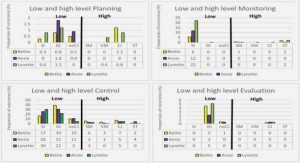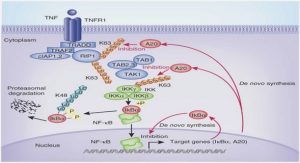Get Complete Project Material File(s) Now! »
Chapter Three: Uncertainty Evaluation Framework
Executive Summary
In order to utilise the tools described in the previous chapter, a clear compartmentalisation of the model into its components is necessary. Once this has been achieved, allocating the types and sources of uncertainty (whether epistemic or aleatory) to each component should be far more straightforward. For this, the state-space structure, r = f ( ME,θ, Et ,C t ,e) is defined such that the real world r is predicted to behave as a function f of the model’s state equations, ME, input parameters θ, calibration and environmental data Ct and Et , and residual stochasticity ε. Based on this state-space structure, tools to help curate information, to diagnose the most important sources of uncertainty, and to identify UE objectives have been developed. This clear UE framework will help save time and resources, and add confidence in conclusions by ensuring that no available resources are overlooked but are rather utilised as well as possible.
A State-space Framework
Components of a Computer Simulation Model
Many bio-physical agricultural and agro-ecosystem computer simulation models are dynamic in nature. It is useful to adopt a state-space framework and follow the notation of authors such as Gordon et al. (1993) and Cressie and Wikle (2011) to compartmentalise the model. Each component defined in this Section can introduce uncertainty in the computer simulation model, and this is discussed in detail with respect to SIRIUS in Section III. Notation is used such that bold font indicates a vector and non-bold a single variable.
Input Parameters
Input parameters are denoted θ. θ represents independent input information that does not change during the sequential updating process of a dynamic computer simulation model. Examples of input parameters in an agricultural setting could be soil type, cultivar or other ‘scenario’ indicators as discussed by Teixeira et al. (2015) and Holzkämper et al. (2015).
State Equations
The model’s state equations ME jointly define the processes that make up the model. The model outputs are then a function f of all the model components. State equations represent either experimentally derived relationships or theoretical constructs. State equations are mathematical equations that describe the underlying scientific processes of the model. Although the coefficients of these equations may have been derived via a calibration process during the model building phase (O’Hagan 2006), these coefficients and the equations to which they relate are distinct from the input parameters as they are usually constant for all scenarios under which the model might be expected to simulate crop responses. For example, the thermal-time calculation used to drive phenological development of lucerne (Teixeira et al. 2009) or the vernalisation requirement for wheat (Brooking 1996).
Observation Data
Data which are observed are denoted Dt . The subscript t identifies individual points at the time step the dynamic computer simulation model operates on (e.g. week/day/hour). Observation data may be present at each time point t, only at selected time points, or on some more or less precise scale. The notation t will be used to signify values that will update in some way related to the computersimulation model’s time step.
Types and Sources of Uncertainty and Their Allocation to Model Components
Computer simulation models represent detailed scientific understanding of real-world systems. Although a vital part of research and development, they are simplifications of reality and hence imperfect. Imperfections may arise to epistemic uncertainty, or the lack of exact knowledge (Refsgaard et al. 2007). Imperfections can also arise because of random variation of a real world process (aleatory uncertainty). The types and sources of uncertainty in computer simulation models have been discussed extensively in the literature (O’Hagan et al. 1999; Kennedy and O’Hagan 2001; Katz 2002; Spiegelhalter and Best 2002; O’Hagan 2006; Cressie and Wikle 2011; Gupta et al. 2012). Epistemic and aleatory sources of uncertainty are aligned with model components next and in Table 1. Elements of equation (5) are red to help identify where the source of each type of uncertainty is allocated.
Epistemic Uncertainty
Input parameter uncertainty r = f ( ME, θ, Et ,C t ,e) is also known as ‘state of the world’ uncertainty. It refers to uncertainty about the appropriate values to describe the scenario to be modelled.
Data uncertainty r = f ( ME,θ, Et , Ct ,e) may enter due to bias or scaling/aggregation. Scaling/aggregation uncertainty refers to situations in which the model is used on a scale different from that on which it was developed to operate. This is sometimes known as change of support (Katz 2002; Cressie and Wikle 2011). Bias occurs when the model is used on a scale different from which it was developed to operate. Calibration data, r = f ( ME,θ, Et , Ct ,e) , is used when calibrating or updating predictions with actual observations. Environmental input data, r = f ( ME,θ, Et ,C t ,e) , is used directly to inform state equations and can introduce uncertainty both as set of imperfectly measu
Structural uncertainty, r = f ( ME,θ, Et ,C t ,e) , is also known as model inadequacy (Gupta et al. 2012), state equation uncertainty, or ‘ignorance’. It refers to our basic lack of knowledge concerning the structure of the model relative to the processes they represent. This may be in the nature of the state equations r = f ( ME,θ, E ,C ,e) , or the more inclusive model form r = f ( ME,θ, E ,C ,e) .
The obvious symptom is the difference between the true mean value of the real world process and the model output at the true values of the input data and parameters.
An additional source of uncertainty that must be discussed is code uncertainty which arises when the response surface of model outputs is sampled (Kennedy and O’Hagan 2001). This type of uncertainty is only briefly touched on through this dissertation and sits outside the UE framework proposed here as it is describes uncertainty from the truth of the model as opposed to truth of the real system. There exists situations in which a particularly large or complex model is difficult to evaluate due to the length of time taken to run a single simulation. In these situations an emulator approach can be used to predict how a computer simulation model (computer simulation model) might be expected to behave, based on a small number of actual runs of the computer simulation model. Estimates of the ‘code’ uncertainty around the computer simulation model expected values can then be obtained (Kennedy and O’Hagan 2001).
1. Motivation, Outline and Research Justification
1.1 Research Motivation
1.2 Outline
1.3 How the Research Fits In
1.4 Summary
2. Setting the Scene
2.1 Executive Summary
2.2 Introduction to Computer Simulation Models
2.3 Terminology
2.4 Bio-physical Agricultural Computer Simulation Models
2.5 State-space Modelling, Probability and Data
2.6 Bayesian Data Analysis
2.7 Putting It All Together
2.8 Summary
3. Uncertainty Evaluation Framework
3.1 Executive Summary
3.2 A State-space Framework
3.3 Framework for Robust Computer Simulation Model UE
3.4 Summary
4. UE Techniques
4.1 Executive Summary
4.2 Introduction
4.3 Sampling: Design of computer experiments to generate output data
4.4 Analysis/Summary of Simulated Data
4.5 Summary
5. Scientific modelling of wheat flowering time physiology
5.1 Executive Summary
5.2 Introduction
5.3 Biological Motivation: Estimate Flowering Time in Wheat
5.4 The Physiology of Leaf Development in Wheat
5.5 Overview of the History of Modelling in Wheat .
5.6 SIRIUS in the Spotlight
5.7 Conclusion
6. Historical Data Analysis
6.1 Executive Summary
6.2 Photoperiod Response
6.3 Prediction of Leaf Appearance in Wheat: A Question of Temperature
6.4 Remaining Papers
6.5 Summary
7. A model as a live framework for research
7.1 Executive Summary
7.2 Introduction
7.3 Benefits of Deeper Sowing
7.4 Experiments
7.5 Materials and Methods
7.6 Results
7.7 Discussion
7.8 Summary
8. UE Framework and Sensitivity Analysis
8.1 Executive Summary
8.2 Application of the UE Framework
8.3 Sensitivity Analysis of the Input Parameters
9. SIRIUS implemented as a State-Space model via MCMC
9.1 Executive Summary
9.2 Introduction
9.3 Formulation of the Model via Bayes Theorem
9.4 Practical Implementation
9.5 Results of UE
9.6 Diagnostics
9.7 Alternative Formulations
9.8 Estimation of Uncertainty in a Latent Variable
9.9 Summary
10. Uncertainty estimation for latent state variables
10.1 Executive Summary
10.2 A Mixture Distribution to Reduce Uncertainty for a Latent Variable
10.3 Sensitivity Analysis of Latent State Equations
10.4 Summary
11. Conclusion
11.1 Introduction
11.2 What Was Done
11.3 The Pathway
11.4 Key Outcomes – UE Framework
11.5 Key Outcomes – Bayesian Data Assimilation
11.6 Further Work and Limitations of the Research
11.7 Conclusion
Appendices
GET THE COMPLETE PROJECT
Approaches to Describe and Quantify Uncertainty in Bio-physical Agricultural Computer Simulation Models




